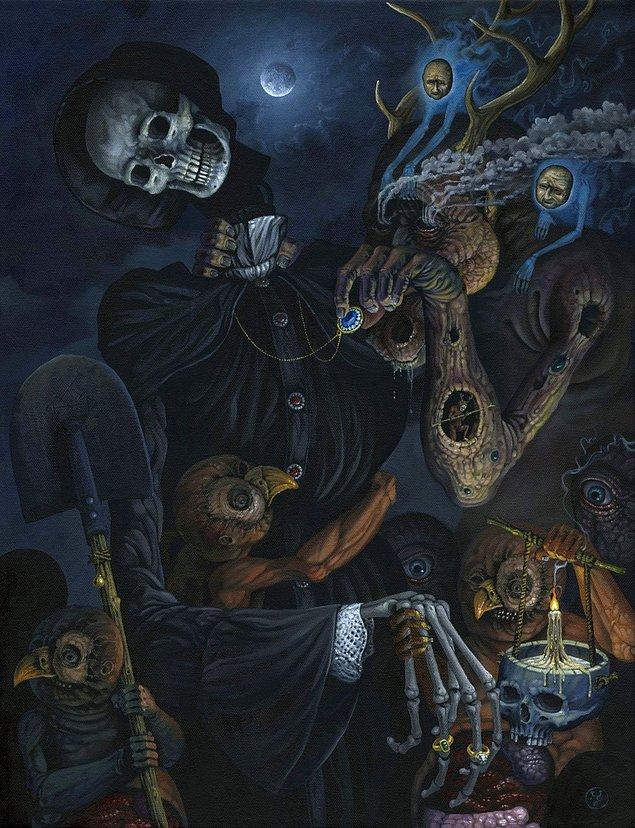Perhaps that is why the world got so sad when the Empire crumbled. 1485 by Hans Memling 22 The Garden of Earthly Delights 1505 by Hieronymus Bosch 23 The Triumph of Death 1562 by Pieter Bruegel the Elder 24 The Flaying of Marsyas 1576 by Titian 25 Portrait of Antonietta Gonzalez 1595 by Lavinia Fontana.
Henry Fuseli 1741-1825 The nightmare.

. The period covers 5 to 10th century CE. Painted between 1490 and 1510 the work is a northern renaissance masterpiece that inspired generations of Artists to portray the darker side of their imaginations. Henry Fuseli Public domain via Wikimedia Commons.
Death and the Miser Hieronymus Bosch The 15th-century painting depicts the last moments in the life of a miser. The Dark Ages refers to the cultural economic and artistic decline that took place after the collapse of the Roman Empire. Hell Hieronymus Bosch.
Here are some of the most important and famous paintings of the Renaissance. The Renaissance Era was the rebirth of European culture art politics and even economics. Forget binge-watching horror flicks on Netflix-- just scroll through this collection of scream-inducing artworks.
Choose your favorite nightmare paintings from 3127 available designs. 1500-1505 Image source now housed in the Museo del Prado in Madrid Spain. He painted people in action with the exuberance and energy of Baroque artists.
The universe of manipulation. Hieronymus Bosch The Garden of Earthly Delights Hell panel c. Not all is dark and gloomy however.
The Nightmare ArtistHenry Fuseli Year1781 MediumOil on canvas Dimensions1016 cm 127 cm LocationDetroit Institute of Arts Detroit Michigan The Nightmare is a 1781 oil painting by Swiss artist Henry Fuseli. Happy All Hallows Eve. The work is one of the 14 Black Paintings that Goya painted directly onto the walls of his house between 1819 and 1823.
Add a wonderful accent to your room and office with these posters that are sure to brighten any environment. From images of Alice Cooper in concert to artwork of Jack Skellington this collection is as diverse as it is unnerving. The painting Mona Lisa by Leonardo Da Vinci is one of the most famous and recognized paintings in history.
Her head and arms hang down the right edge of the bed as well as her blond hair. Solid-Faced Canvas Print entitled Still Life with a Kettle. Another one of the most famous demon paintings was done by the well-known Dutch painter who lived and worked in the early Renaissance period.
2 Famous Scary Paintings 21 Triptych of Earthly Vanity and Divine Salvation c. Other pieces in this collection are. There were not many advancements with science and this was a time of war famine and the Black Plague.
The Nightmare Painting By Henry Fuseli And Thomas Burke Print Poster Museum-quality posters made on thick and durable matte paper. The paintings of 17thcentury artists express a definite stylistic trend called the pittura tenebrosa- a compositional technique where large areas of the paintings are immersed in darkness sometimes an absolute black to plunge certain parts of the image into obscurity leaving only one or more points of illuminations. The beast and its master walking a silent path.
1790-91 version Another Neo-Baroque French painter Gericault 1791-1824 explored human extremes and violent action in his art. 56 ozy² 192 gm² Giclée printing quality Opacity. The Romans definitely knew how to party.
Taking reference from Bosch Huys complicated scenes include hundreds of angles demons half. Eight fine art photographs aimed to appear on gallery walls. Pieter Huys a Flemish renaissance painter c1519c1584 brought his own brand of terrifying creatures and darkness created in his Antwerp workshop.
Many people take a certain interest in the macabre and this collection of nightmare paintings fits the bill. The paintings dreamlike and haunting. The Nightmare 1781 by Henry Fuseli.
In these two paintings the left one being from the Middle Ages and the right from the Renaissance period the image of Mary with Jesus is shown although much differently. The cross of carcases. Mounted Officer of the Imperial Guard 1812 oil on canvas 97x64 the Louvre Paris.
A demon holding a fiery lantern and a rat-faced beast inside the chest holding a bag of gold. Made in the USA. Since Halloween is less than a dozen days away we couldnt help dedicate this weeks roundup of overlooked and adored paintings to the scariest themes in art.
The Renaissance was the era which took place after the Middle Ages which was a dark time for Europe. It shows a woman in deep sleep with her arms thrown below her and with a demonic and apelike incubus crouched on her chest. Much in the art of Goya is derived from that of Velázquez just as much in the art of the 19th-century French master Édouard Manet and the 20th-century genius Pablo Picasso is taken from Goya.
In The Nightmare painting Henry Fuseli depicts a darkened interior scene where we see a woman lying on her bed appearing to be in deep sleep or either unconscious. The Middle Age painting shows Mary and Jesus on a throne and of more of a royal standing while the Renaissance painting shows them in more contemporary clothing similar. Unarguably it is the most discussed painting because of the enigmatic smile.
Primary colors within this image include Peach Silver Dark Forest Green. Large Solid-Faced Canvas Print Wall Art Print entitled The Nightmare 1781. Hieronymus Bosch is credited with creating some of the most notable works from this era as many of the most famous Renaissance painters had not emerged yet.
Dark Ages To Renaissance The Roller Coaster Of History. 103 mil Paper weight.

21 Silverthorn Ideas Dark Art Art Art Inspiration

Nightmare Jeremiah Morelli Artwork On Useum

The Nightmare By Henry Fuseli Article Khan Academy

Nightmare 1781 82 By Fuseli Oil Painting Reproduction For Sale

Gargoyle On Your Chest Nightmares Art Art Incubus Demon

35 Of The Most Gruesome And Unsettling Paintings In Western Art Onedio Co


0 comments
Post a Comment